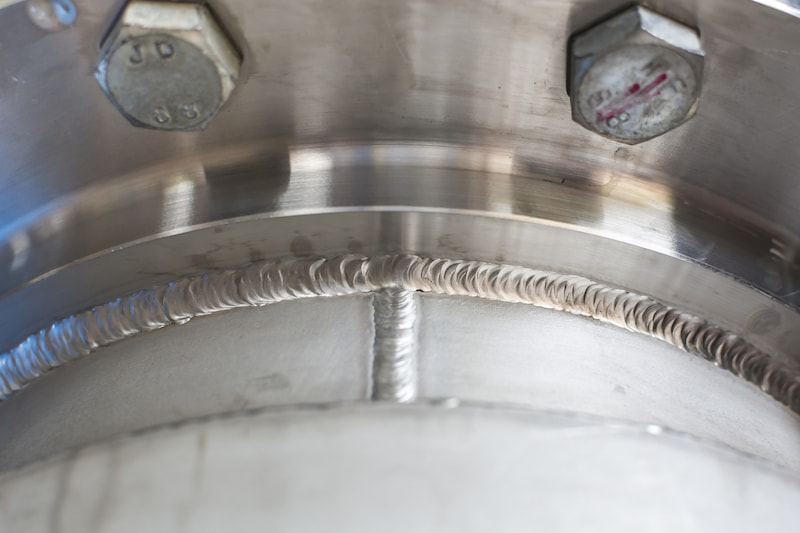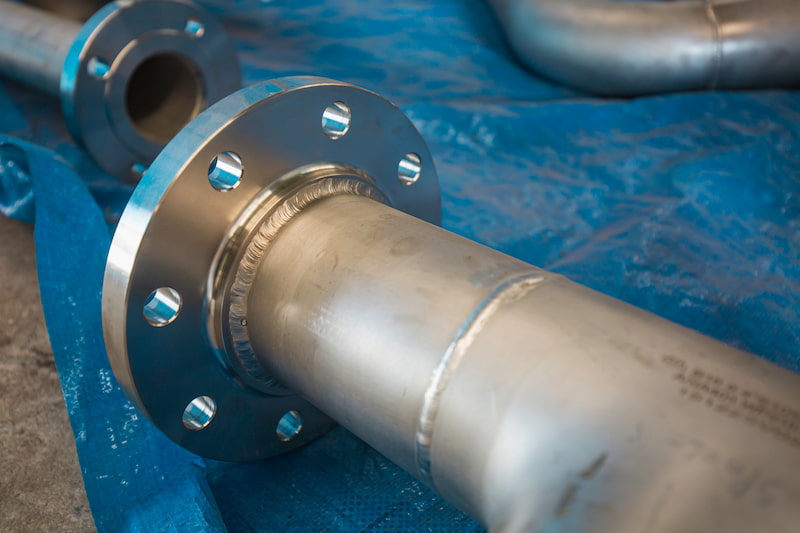Stainless steel is a widely used metal used by most sectors due to its proven durability, corrosion resistance and aesthetic appeal. It shares similar properties to carbon steel but with at least 10.5% chromium content for added resistance to corrosion.
Let’s explore the unique characteristics of welding stainless steel to maximise its overall result.
- Stainless steel has low thermal conductivity and high thermal expansion, presenting challenges such as warping, cracking, and rust during welding.
- Common welding methods for stainless steel include TIG, MIG, SMAW, FCAW, resistance, and friction welding, each with specific advantages and applications.
- Effective welding practices involve choosing the right filler material, adjusting welding parameters, and using proper shielding gas to prevent contamination and achieve high-quality welds.
The Challenges in Welding Stainless Steel
Stainless steel welding, in particular, presents a unique set of challenges in welding from its mechanical properties. Its various grades and types (such as austenitic, ferritic, martensitic, precipitation-hardened, Duplex, etc) add an extra layer of complexity to the subject.
Let’s explore a few of the challenges in welding stainless steel and learn how to overcome them.
Warping & Cracking
Stainless steel has low thermal conductivity and high thermal expansion, making it susceptible to warping and cracking. Excessive heat input during welding or a rapid change in the temperature puts the metal under stress, resulting in distortion as it cools down.
There are a few ways to prevent warping and cracking, one of which is through working with lower heat input. While it may seem logical, it also may result in poor weld quality due to incomplete fusion between the workpieces. So it is always important to strike a balance between the two extremes. Another solution is to create a heat sink by clamping copper or brass behind the seam, absorbing unnecessary heat into the copper alloys.
Rust
Stainless steel is known to have high corrosion resistance, yet excess heat may still generate rust in the weld. It may also form as the carbon from the filler material contaminates the heat-affected zone.
Choosing an optimal welding temperature and a stainless steel filler alloy depending on the job greatly reduces the risk of forming rust in the material.
Welding Dissimilar Steels
Welding dissimilar metals or various stainless steel grades together can be challenging, especially if their melting points are far apart. It might cause great trouble in fusing the metals effectively.
Selecting the optimal filler rod is necessary when welding stainless steel and another alloy. Preheating the metals can also alleviate this problem.
Switching Between Jobs
The lower melting temperature of stainless steel (1375 – 1530°C) compared to mild steel (1425-1540°C) might become problematic when switching between the two.
Toxic Fumes
Stainless steel welds produce toxic fumes in the form of hexavalent chromium gas. It develops as the chromium oxide layer is destroyed and may occur either during the heating or cooling process.
An effective breathing mask combined with proper ventilation in the area is key to ensuring the welder’s safety.
Stainless Steel Welding Methods
Depending on the project’s requirements, several welding processes can be performed to join stainless steel parts. We’ll highlight a few of those processes but this is not an exhaustive list, processes such as plasma welding, electron beam welding, submerged arc welding, etc are all perfectly capable of welding stainless steels as well.
TIG Welding (GTAW)
TIG welding is widely used in the fabrication sector for stainless steel since it has a stable arc and the process is automated. In the TIG process, the heat applied to the weld can precisely be controlled through a foot pedal or finger control, minimising the possibility of warping. TIG welding machines can also switch between AC and DC polarities, offering flexibility and convenience simultaneously.
Gas tungsten arc welding stainless steel is rather costly since the process needs consumables such as shielding gas (usually pure argon) and optional filler rods. Selecting the right geometry and size of the electrode depending on the welding variables should definitely be considered beforehand.
MIG Welding (GMAW)
MIG welding is another popular choice for welding stainless steel. It offers faster speeds than TIG welding mainly thanks to its continuously fed electrode. One downside of this technique is that it doesn’t look as pleasing to the eye as properly executed TIG welds.
A Teflon wire liner in the MIG gun allows for a consistent wire feed to the weld pool and added protection from contamination. Backstepping, staggering or allowing the joint to undergo a bit of the cooling process helps avoid warpage since stainless steel retains heat well.
Shielded Metal Arc Welding (SMAW)
Stick-welding stainless steel is often the practical choice regarding cost, portability and simplicity. SMAW can be performed in almost any environment and thus is great for various repair jobs and welding stainless steel outdoors.
Thicker pieces of stainless steel (above 2mm) are most suitable for SMAW since it is harder to control the heat input than with other methods. Selecting the electrode (typical grades: 316, 308, or 312) is an important part of the project. Beware of slag removal after the welding as it might be a bit of a struggle.
- Personal account manager
- Quality assurance
- Payment terms for companies
- On-time delivery by Fractory
Flux Cored Arc Welding (FCAW)
Flux-cored arc welding stainless steel is sometimes preferred over SMAW since it generally creates a more uniform weld bead. FCAW can be performed with a shielding gas when working with varying material thicknesses or in demanding welding conditions.
A 10° drag angle allows the flux to rise at the weld pool and gives enough bead coverage.
Resistance Welding
Resistance welding (spot welding, seam welding) stainless steel creates clean welds compared to arc welding processes since it doesn’t use filler material and has no risk of weld spatter. The high electrical resistance of stainless steel is also favorable since it can complete a weld in a short amount of time.
A good quality welder with sufficient power output is necessary for resistance welding stainless steel to prevent the areas close to the HAZ from deformities. It is recommended to have higher current and voltage values when welding stainless steels compared to, for example, copper and aluminium alloys due to the difference in electrical conductivity.
Friction Welding
ARVE error: url: https://www.googleapis.com/youtube/v3/videos?part=snippet%2Cstatistics&id=f6qYYJ3D3lM&key=AIzaSyAQ7WFzTAUrOX-FjsIrFS3JwZBFzgIvloc Status code 200 expected but was 403.
Friction welding stainless steel, similar to resistance welding, doesn’t use consumables, making it an economical choice when the part geometries allow for it. It is most suitable for welding austenitic stainless steel due to its composition of chromium (16-26%) and nickel (8-22%).
Some factors that need to be considered are friction pressure, burn-off length and rotational speed. Some sub-types of friction welding may be suitable for specific applications: friction hydro pillar processing (FHPP), friction stir welding (FSW) and friction plunge welding.
Stainless Steel Welding Best Practices
Safety and Preparation
Preparation of equipment, materials and the work area is essential before engaging in any kind of welding process suitable for stainless steels. A dedicated stainless steel wire brush to prepare the metals will decrease the chances of contamination. Gloves, goggles and other protective gear will minimise the risk of accidents such as exposure to fumes and injury due to spatter. Following these safety measures can further be complemented with welding liability insurance to further safeguard business operations.
Filler Metal Selection
Choosing the appropriate filler material depending on the scope of work is really important. Most of the time it should match the grade of the stainless steel, achieving almost the same properties. Other considerations in choosing filler material include weld joint design, aesthetics and overall weld performance.
Parameters
An experienced welding provider understands the finer details of each stainless steel grade, weldable metals and welding method. It leads to a better choice when fine-tuning the parameters such as the power supply, torch angle, travel speed and deposition rate. Effective use of these welding parameters will help to achieve the highest quality welds.
Shielding Gas
The choice of shielding gas in processes such as MIG and TIG welding is crucial in protecting the weld pool from contamination. The correct shielding gas composition will reduce the risk of weld defects and improve the weld’s overall outcome.
Heat Input
Consider the variables of the welding project in determining the ideal heat input to weld stainless steel. Generally, the welding current should be about 20% less than for carbon steel to prevent corrosion.





